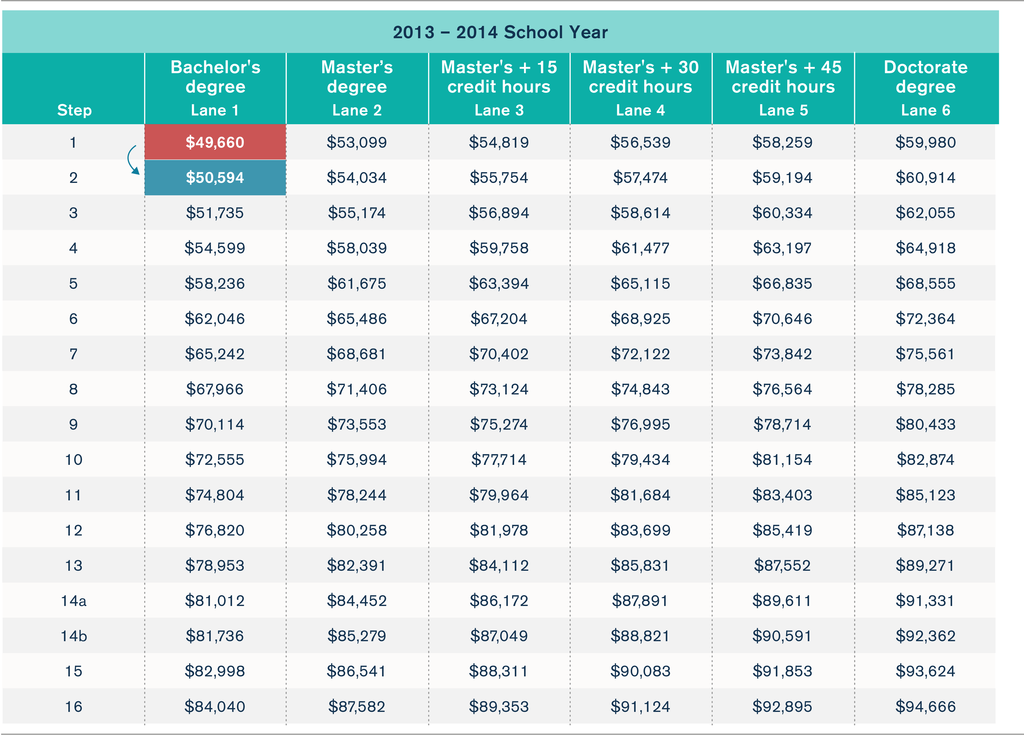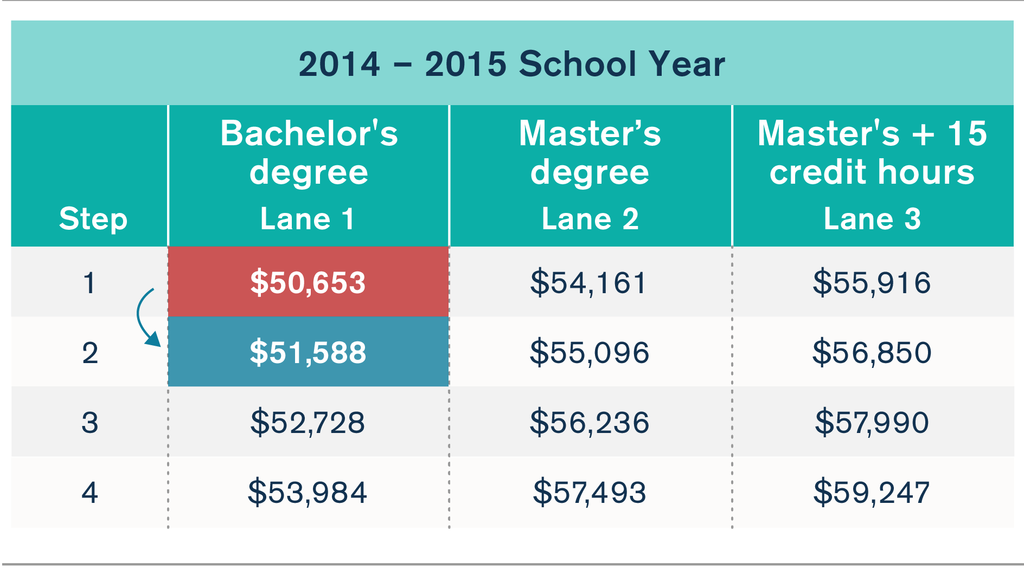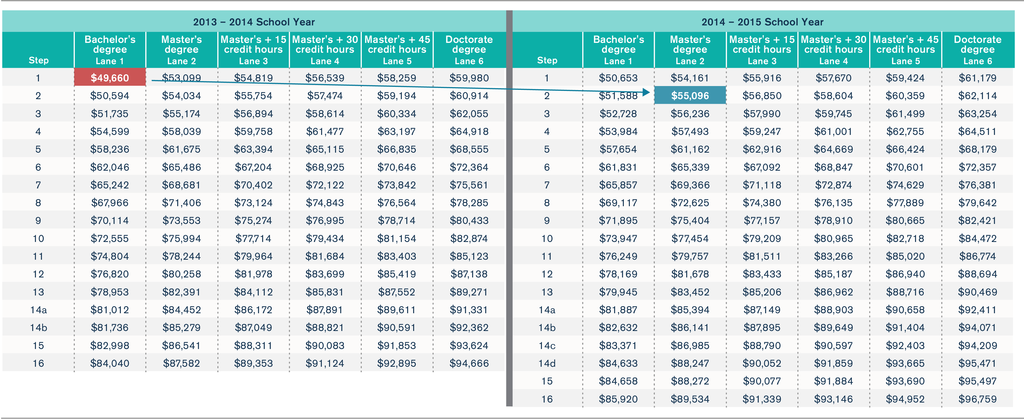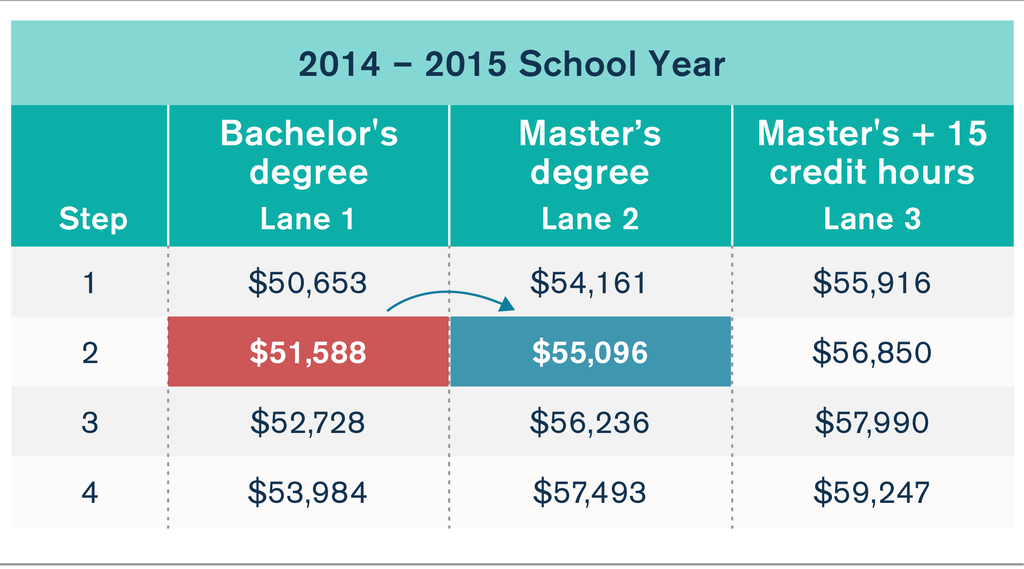Steps and lanes: Understanding how Chicago public school teachers get multiple pay raises each year
Chicago teachers’ salaries are based on a complex and convoluted system that has provided teachers with annual pay increases well in excess of the 2.75 to 3 percent raises proposed by the district.
The negotiations between Chicago Public Schools, or CPS, and the Chicago Teachers Union, or CTU, over a new contract have ground to a halt with both sides blaming the other for the lack of a deal.
One of the main points of contention has been raises and how the teachers’ salary schedule will function in the next contract.
Along with annual automatic raises to members’ salaries, the salary schedule for Chicago teachers also contains automatic salary bumps called “step and lane” increases that add to teachers’ total compensation. “Steps” refer to tenure, or how many years a teacher has been teaching, and “lanes” refer to the level of education the teacher has attained.
The 2012 Chicago teachers’ contract had 16 steps. A teacher earns a step raise for every year of service until he or she reaches 16 years of service. The contract also had six lanes. A teacher changes lanes and receives a higher salary as he or she reaches higher levels of education, from a bachelor’s degree all the way up to a doctorate.
CTU President Karen Lewis has called those automatic salary bumps “part and parcel of the way we do business,” and a “bedrock of our professionalism.”
They’re also part of a complex, convoluted system that deceives members of the public into thinking teachers are getting smaller raises than they actually are.
Public school teachers unions across Illinois have clung to such outdated pay schemes for decades, despite evidence that shows salary schedules reward teachers for things that have little to do with improving student outcomes. Salary schedules pay all teachers in the same step and lane the same salaries, regardless of that teacher’s skill, effectiveness or achieved outcomes for students.
Raises based on a teacher’s education level also waste taxpayer dollars. Numerous studies have demonstrated that boosting teacher pay based on a teacher’s education is inefficient and does nothing to enhance student achievement.
Taking a closer look
Looking at how much a hypothetical CPS teacher made during the 2013-2014 and 2014-2015 school years provides a better understanding of how teachers’ salary schedules work.
In the following two examples, at first glance it might appear that the teacher is only receiving a 2 percent raise.
However, due to steps and lanes, the salary increases the teacher receives are actually much higher.
Example: Taking a step
A newly hired teacher in 2013 with a bachelor’s degree occupies step 1 (first year), lane 1 (bachelor’s degree) in the 2013-2014 salary schedule.
According to the salary schedule, this teacher earned $49,660 during his or her first year.
Following this pattern, one might expect that this teacher would occupy step 2 (second year), lane 1 (bachelor’s degree), in the second year. This would entitle the teacher to $50,594 in pay – a 1.88 percent increase over the previous year’s salary.

But that’s not how it works.
The 2014-2015 salary schedule, which governs pay in the teacher’s second year, determines how much the teacher makes.

The now second-year teacher moves to the higher salary of $51,588 in step 2, lane 1 for an increase of 3.9 percent – not 1.88 percent – over the previous year’s pay.
That total increase of 3.9 percent comes from two changes to the teacher’s salary:
1. The teacher receives a 2 percent annual raise by moving to step 1, lane 1 under the 2014-2015 salary schedule, from step 1, lane 1 under the 2013-2014 salary schedule. The base salary increases because the entire salary table shifts between 2013-2014 and 2014-2015.

Thus, the 2013-2014 $49,660 salary in step 1, lane 1 rises to $50,653 in 2014-2015. That’s an increase of 2 percent. That’s the raise to which CTU officials refer when they talk about teachers’ “2 percent” annual raises.
2. However, the teacher also receives an additional 1.85 percent salary increase in the form of a step increase. For completing another year of service, the teacher moves to step 2 from step 1 under the 2014-2015 salary schedule.

So, combining the annual 2 percent raise that occurs due to a year-over-year spike in salaries with a 1.85 percent step increase, the teacher’s salary rises to $51,588 from $49,660, an increase of 3.9 percent in one year.
That’s nearly double what the teacher is usually reported as receiving.
Example: Changing a lane
On top of an annual raise and a step increase, teachers can also earn a third raise through a lane increase. Teachers move from lane to lane by advancing from a bachelor’s degree to a master’s degree to a doctorate.
For example, assume the teacher from the example above was on the cusp of obtaining a master’s degree. According to the 2013-2014 pay schedule, that teacher would occupy step 1 (first year), lane 1 (bachelor’s degree) and would earn $49,660 during the first year of teaching.

Assuming the teacher earned a master’s degree during the course of the 2013-2014 school year, the salary schedule dictates a move to step 2, lane 2 in the 2014-2015 school year. The teacher’s salary, then, would total $55,096 in 2014-2015 – a 10.95 percent raise over the previous year’s pay.
Thus, the 10.95 percent increase comes from three changes to the teacher’s salary:
1. As in the first example, the teacher receives a 2 percent annual raise by moving to step 1, lane 1 under the 2014-2015 salary schedule from step 1, lane 1 under the 2013-2014 salary schedule. This is due to an increase in all levels of base salary that occurs between the 2013-2014 and 2014-2015 school years.

The 2013-2014 school year’s $49,660 salary in step 1, lane 1 shifts to $50,653 in 2014-2015 for an increase of 2 percent.
2. The teacher also receives an additional 1.85 percent salary increase in the form of a step increase. For completing another year of service, the teacher moves to step 2 from step 1 in the 2014-2015 salary schedule.

3. In this example, the teacher receives an additional 6.8 percent raise due to a lane increase. The teacher’s salary moves to step 2, lane 2 from step 2, lane 1 in the 2014-2015 salary schedule because he or she obtained a master’s degree.

So together, the annual raise of 2 percent and the combination of the 1.85 percent step increase and the 6.8 percent lane increase raise the teacher’s salary to $55,096 from $49,660, or 10.95 percent.
That raise is five times greater than the increase that the teacher was officially reported as receiving.
Result: Teacher raises are more than just annual raises
As the examples above demonstrate, step and lane increases can have a significant effect on teacher salaries. And due to steps and lanes, most teachers’ yearly raises are much higher than what the union says and the media usually reports.
So when the CTU talks about the economic hardship and miniscule salary increases its members have received, remember that the union isn’t telling the whole story.
To see the complete previous pay schedule for Chicago Teachers Union teachers, click here.

